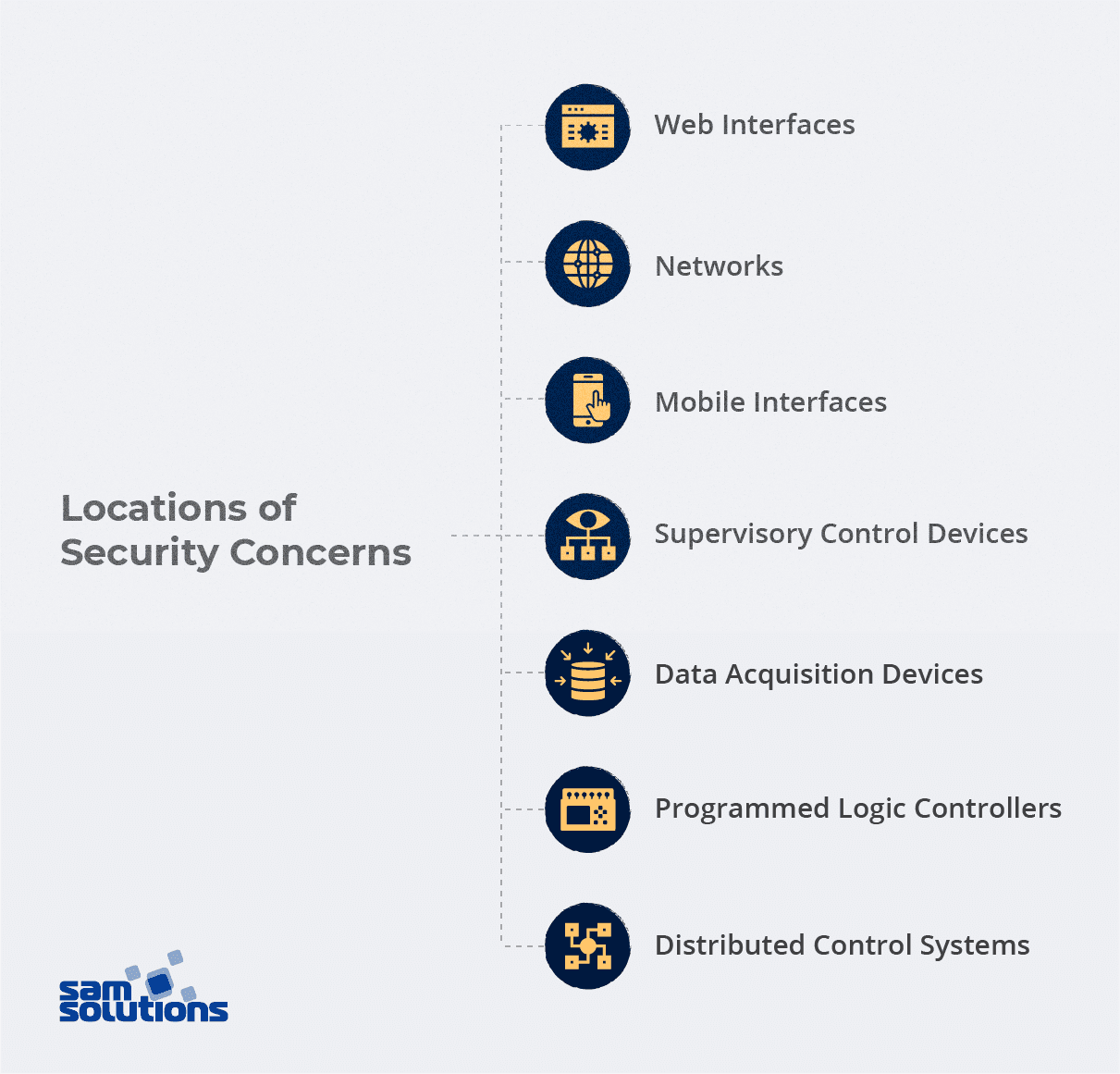IoT technologies have brought huge benefits for manufacturing, transport, oil and gas, healthcare, AgroTech, energy, and utilities sectors. These industries have complex infrastructures, bringing together a great number of interconnected devices, sensors, smart meters, industrial robots and software used for communication and data transmission. Industrial IoT systems contain important sensitive information, and therefore pose as tempting targets for hackers. Continue reading this article to learn more about IIoT vulnerabilities and ways to eliminate them.
Transform your business or gain a competitive advantage in your industry with custom IoT software solutions from SaM Solutions.
IIoT Security Challenges and Expectations
Quality Assurance
Smart devices should regularly undergo comprehensive testing procedures to ensure that they function properly and do not pose any risks to endpoint security. Timely support and maintenance services are of utmost importance if we want to achieve a high level of protection against cyber attackers.
Threat Identification
A common network simultaneously connects a number of devices. This makes it difficult to identify the exact source of a threat. It is good practice to create special threat identification modules that help recognize vulnerable points in both the software and the hardware of the ecosystem.
Hardware Configuration
The importance of hardware integration is sometimes overlooked. However, to ensure smooth performance of the ecosystem, this is an important factor to consider. Proper hardware configuration helps make the infrastructure secure and prevent illegal access by attackers trying to change the default configuration, steal data and disrupt the system.
Data Encryption
To ensure the privacy of users and provide safe storage of their personal details, software developers implement encrypted data. To comply with the established data encryption regulations, cryptography protocols are implemented. These methods help protect sensitive information and make all interactions with the infrastructure secure.
IIoT Device Cyber Vulnerabilities
Thanks to smart devices, there are ample opportunities to share and exchange data remotely. At the same time, these technologies are vulnerable to hackers as they are relatively easily compromised. Earlier, there were not many problems with security at a technical level, so the majority of industries and manufacturers didn’t have special standardized guidelines and protocols on how to deal with them.
Organizations solved security issues ad hoc, turned to third-party security service providers for help, used unreliable legacy equipment, or counted on the client’s internal security alone. These measures have proven insufficient for proper protection because of the weak points of a typical industrial IoT infrastructure.
Get SaM Solutions’ IoT consulting or development services to deliver a competitive IoT product cost-effectively.
Below we will consider what features make the IIoT system vulnerable.
- The devices are always turned on, so they are always visible to hackers.
- Outdated common code libraries are used.
- Necessary security features are often absent.
- Passwords are not strong enough.
- Authentication processes are not elaborated properly.
- There are no established security protocols.
- The firmware is obsolete.
The main reason why smart devices are such attractive targets is their connection to internal services with important information. Industries often do not segment their IoT network, as this makes it easier to manage than a complex segmented one. Nevertheless, this approach can harm information security. When attackers hack a single device in the unsegmented network, it is easy for them to wreak havoc on the entire system.
In addition, if one small device is attacked, it can potentially disrupt the performance of all the connected devices and systems of other organizations. Thus, the harm is often not limited to just one organization, but can also affect the security of its partners and vendors.
Locations of Security Concerns

There are numerous typical locations of security concerns in the industrial IoT system. First of all, cyber attackers can get unauthorized access to a badly protected network in different ways – via an open port, buffer overrun, DoS and DDoS attack. Then, if the web interface is insecure, hackers can take advantage of unprotected data, weak passwords, technical issues with lockout and session control.
The most vulnerable parts in the infrastructure are supervisory control and data acquisition devices, programmed logic controllers, distributed control systems, web and mobile interfaces that provide interaction between humans and machines.
Encryption is a key factor that is often underestimated by industries. If the encryption is not strong enough or is absent, attackers can easily access confidential details during data transmission between devices. Mobile interfaces are targets for hackers as well. The most common problem with them is data breach due to poor encryption and authentication.
Industrial IoT Security Solutions

IIoT infrastructure is versatile and consists of numerous devices and systems. The industry is constantly developing, and there is no single out-of-the-box solution that can protect IIoT from external threats. Therefore, a multifaceted approach needs to be adopted in implementing security measures. Below we will consider the most effective industrial IoT security solutions.
Segmentation is an extremely beneficial solution. If equipment and programs are kept in a separate network after IIoT deployment, a service attack would not influence other devices that belong to a different segment of the ecosystem. To manage user access to data effectively, it is recommended to change credentials after account activation, limit the number of tries while entering a password, and set account lockout after the wrong login and password are entered several times.
Leverage the latest IoT technologies with our expert team and get powerful IoT solution for your business.
To increase the level of protection, it is advisable to create strong passwords and two-factor authentication access. Encrypted communication will help you protect digital data confidentiality. It is also important to ensure that you don’t forget to close the ports on time and that you protect IoT infrastructure from buffer overrun. Advanced services such as voice recognition systems, biometrics, or the principle of least privilege (PoLP) can be used to detect and prevent potential hazards.
Timely upgrade of the installed firmware is necessary for stable and reliable functioning of the system. Organizations should adhere to the principles of strict software development, create rigorous security standards and protocols, and conduct security audits on a regular basis.



















 The Latest 15 Information Technology Trends in 2024
The Latest 15 Information Technology Trends in 2024 Top 10 Embedded Software Development Tools
Top 10 Embedded Software Development Tools IaaS vs. PaaS vs. SaaS: What’s the Difference?
IaaS vs. PaaS vs. SaaS: What’s the Difference? 10 Examples of Predictive Analytics
10 Examples of Predictive Analytics












 Web App Development Cost in 2025 [Key Price Factors]
Web App Development Cost in 2025 [Key Price Factors] 13 Best React Development Tools in 2025
13 Best React Development Tools in 2025 Top 10 Mobile App Development Trends 2025
Top 10 Mobile App Development Trends 2025 Top IoT Industry Trends in 2025
Top IoT Industry Trends in 2025 Java Web App Security: Everything You Need to Know
Java Web App Security: Everything You Need to Know
Hello! I’ve been reading your web site for a long time now and finally got the bravery to go ahead and give you a shout out!
For me, IIoT security is not any more important than corporate or home IoT security. The whole world is connected through the Internet, and we should be careful how we store private data. Two-factor authentication? Yeah, let’s do it!
As a corporate employee, I have to comply with my company’s security protocols. They are strict enough, and I have never witnessed any hacker attacks. While reading this article, it occurred to me that industrial IoT is a lot more complex and requires a different approach.
The more complex the technology, the more vulnerable it is. If I were a security expert, I would make sure the latest best practices are implemented, no matter how costly.
IIoT security is never sufficient if you ask me! Cyber criminals are always looking for new ways to get unauthorized access to confidential data. Similarly, industries should respond to this with counteractions like improving protection and making it impossible for hackers to get to weak points in smart devices.
I work in the healthcare industry, and we are obliged to change our passwords regularly. We receive notifications to update our software every once in a while, and our information department always conducts annual IIoT audits.
Great read! But I disagree that industrial security policies are not developed enough. I’m sure that organizations do their best.
The security issue is a real problem. Industries should definitely pay more attention to security. The thought that confidential information might be stolen and misused is terrifying.